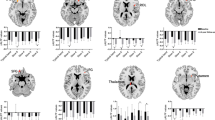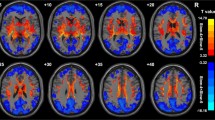Abstract
Spontaneous low-frequency fluctuations (LFF) in the blood-oxygenation-level-dependent (BOLD) functional magnetic resonance imaging (fMRI) signal have been shown to reflect cerebral spontaneous neural activity. The objective of this study was to explore brain functional changes in patients with mild cognitive impairment (MCI) by measuring the amplitude of the BOLD signals. Eighteen amnestic MCI patients and 20 healthy elderly individuals underwent the fMRI scan. The amplitude of LFF (ALFF) was calculated using REST software. MCI patients showed decreased ALFF in the right hippocampus and parahippocampal cortex, left lateral temporal cortex and right ventral medial prefrontal cortex and increased ALFF in the left temporal-parietal joint (TPJ) and inferior parietal lobule. The ALFF value in the right hippocampus and parahippocampal cortex was positively correlated with the scores of Mini-Mental State Exam. Reduced medial temporal lobe activity may implicate the underlying memory impairment mechanisms in MCI. Increased TPJ and inferior parietal lobule activity may indicate the compensatory mechanism in MCI patients. These findings suggest that ALFF analysis could provide a useful tool in the fMRI study of MCI.
Riassunto
Le fluttuazioni spontanee a bassa frequenza dell'imaging a risonanza magnetica funzionale (fMRI), ottenuto tramite segnale dipendente dal grado di ossigenazione del sangue (BOLD), hanno dimostrato di rispecchiare l'attività nervosa spontanea. Lo scopo dello studio è stato quello di indagare i cambiamenti funzionali del cervello, in pazienti affetti da deterioramento cognitivo lieve (mild cognitive impairment, MCI), attraverso la misurazione dell'ampiezza dei segnali BOLD. Diciotto pazienti con diagnosi di MCI e 20 controlli anziani sani sono stati sottoposti ad una sessione di fMRI. L'ampiezza delle fluttuazioni a bassa frequenza (AFBF) è stata calcolata utilizzando il software REST. I pazienti con MCI hanno presentato una riduzione dell'AFBF nell'ippocampo di destra, nella corteccia para-ippocampale, nella corteccia temporale laterale di sinistra e nella corteccia pre-frontale ventro-mediale di destra; l'AFBF era aumentata nella giunzione temporoparietale di sinistra (GTP) e nel lobo parietale inferiore. Il valore dell'AFBF nell'ippocampo di destra e nella corteccia para-ippocampale era positivamente correlato con i punteggi del questionario Mini Mental State. La riduzione dell'attività del lobo temporale mediale potrebbe rappresentare la base dei meccanismi di alterazione della memoria nel MCI. L'incremento dell'attività nella GTP e nel lobo parietale inferiore potrebbe indicare un meccanismo compensatorio nei pazienti con MCI. Queste evidenze suggeriscono che l'analisi delle AFBF potrebbe essere uno strumento molto utile nello studio fMRI dei pazienti con MCI.
Similar content being viewed by others
References/Bibliografia
Petersen RC, Smith GE, Waring SC et al (1999) Mild cognitive impairment: clinical characterization and outcome. Arch Neurol 56:303–308
Blennow K, de Leon MJ, Zetterberg H (2006) Alzheimer's disease. Lancet 368:387–403
Petrella JR, Krishnan S, Slavin MJ et al (2006) Mild cognitive impairment: evaluation with 4-T functional MR imaging. Radiology 240:177–186
Whitwell JL, Przybelski SA, Weigand SD et al (2007) 3D maps from multiple MRI illustrate changing atrophy patterns as subjects progress from mild cognitive impairment to Alzheimer's disease. Brain 130:1777–1786
Fox MD, Raichle ME (2007) Spontaneous fluctuations in brain activity observed with functional magnetic resonance imaging. Nat Rev Neurosci 8:700–711
Greicius MD, Srivastava G, Reiss AL, Menon V (2004) Default-mode network activity distinguishes Alzheimer's disease from healthy aging: evidence from functional MRI. Proc Natl Acad Sci USA 101:4637–4642
Vannini P, Almkvist O, Dierks T et al (2007) Reduced neuronal efficacy in progressive mild cognitive impairment: a prospective fMRI study on visuospatial processing. Psychiatry Res 156:43–57
Lui S, Deng W, Huang X et al (2009) Association of cerebral deficits with clinical symptoms in antipsychoticnaive firstepisode schizophrenia: an optimized voxel-based morphometry and resting state functional connectivity study. Am J Psychiatry 166:196–205
Remondes M, Schuman EM (2004) Role for a cortical input to hippocampal area CA1 in the consolidation of a long-term memory. Nature 431:699–703
Qi Z, Wu X, Wang Z et al (2010) Impairment and compensation coexist in amestic MCI default node network. Neuroimage 50:48–55
Machulda MM, Ward HA, Borowski B et al (2003) Comparison of memory fMRI response among normal, MCI, and Alzheimer's patients. Neurology 61:500–506
Dickerson BC, Salat DH, Greve DN et al (2005) Increased hippocampal activation in mild cognitive impairment compared to normal aging and AD. Neurology 65:404–411
Bai F, Zhang Z, Yu H et al (2008) Default-mode network activity distinguishes amnestic type mild cognitive impairment from healthy aging: a combined structural and resting-state functional MRI study. Neurosci Let 438:111–115
Zang Y, He Y, Zhu C et al (2007) Altered baseline brain activity in children with ADHD revealed by resting-state functional MRI. Brain Dev 29:83–91
Biswal B, Yetkin FZ, Haughton VM, Hyde JS (1995) Functional connectivity in the motor cortex of resting human brain using echo-planar MRI. Magn Reson Med 34:537–541
Logothetis NK, Pauls J, Augath M et al (2001) Neurophysiological investigation of the basis of the fMRI signal. Nature 412:150–157
Yang H, Long X, Yang Y et al (2007) Amplitude of low frequency fluctuation within visual areas revealed by restingstate functional MRI. Neuroimage 36:144–152
Petersen RC, Doody R, Kurz A et al (2001) Current concepts in mild cognitive impairment. Arch Neurol 58:1985–1992
De Jager CA, Hogervorst E, Combrinck M, Budge MM (2003) Sensitivity and specificity of neuropsychological tests for mild cognitive impairment, vascular cognitive impairment and Alzheimer's disease. Psychol Med 33:1039–1050
Buckner RL, Jessica RA, Daniel LS (2008) The brain's default network: anatomy, function, and relevance to disease. Ann NY Acad Sci 1124:1–38
Dickerson BC, Salat DH, Bates JF et al (2004) Medial temporal lobe function and structure in mild cognitive impairment. Ann Neurol 56:27–35
Grossman M, Koenig P, Glosser G et al (2003) Neural basis for semantic memory difficulty in Alzheimer's disease: an fMRI study. Brain 126:293–311
Teasdale JD, Howard RJ, Cox SG et al (1999) Functional MRI study of the cognitive generation of affect. Am J Psychiatry 156:209–215
Gusnard DA, Raichle ME (2001) Searching for a baseline: functional imaging and the resting human brain. Nat Rev Neurosci 2:685–694
Jonides J, Schumacher EH, Smith EE et al (1998) The role of parietal cortex in verbal working memory. J Neurosci 18:5026–5034
Prvulovie D, Hubl D, Sack AT et al (2002) Functional imaging of visuospatial processing in Alzheimer's disease. Neuroimage 17:1403–1414
Bookheimer SY, Strojwas MH, Cohen MS et al (2000) Patterns of brain activation in people at risk for Alzheimer's disease. N Engl J Med 343:450–456
Buckner RL (2004) Memory and executive function in aging and AD: multiple factors that cause decline and reserve factors that compensate. Neuron 44:195–208
Wang L, Zang Y, He Y et al (2006) Changes in hippocampal connectivity in the early stages of Alzheimer's disease: evidence from resting state fMRI. Neuroimage 31:496–504
Stern Y (2002) What is cognitive reserve? Theory and research application of the reserve concept. J Int Neuropsychol Soc 8:448–460
Author information
Authors and Affiliations
Corresponding author
Rights and permissions
About this article
Cite this article
Xi, Q., Zhao, X., Wang, P. et al. Spontaneous brain activity in mild cognitive impairment revealed by amplitude of low-frequency fluctuation analysis: a resting-state fMRI study. Radiol med 117, 865–871 (2012). https://doi.org/10.1007/s11547-011-0780-8
Received:
Accepted:
Published:
Issue Date:
DOI: https://doi.org/10.1007/s11547-011-0780-8
Keywords
- Mild cognitive impairment
- Resting-state functional MRI
- Amplitude of low-frequency fluctuation
- Medial temporal lobe
- Compensation




